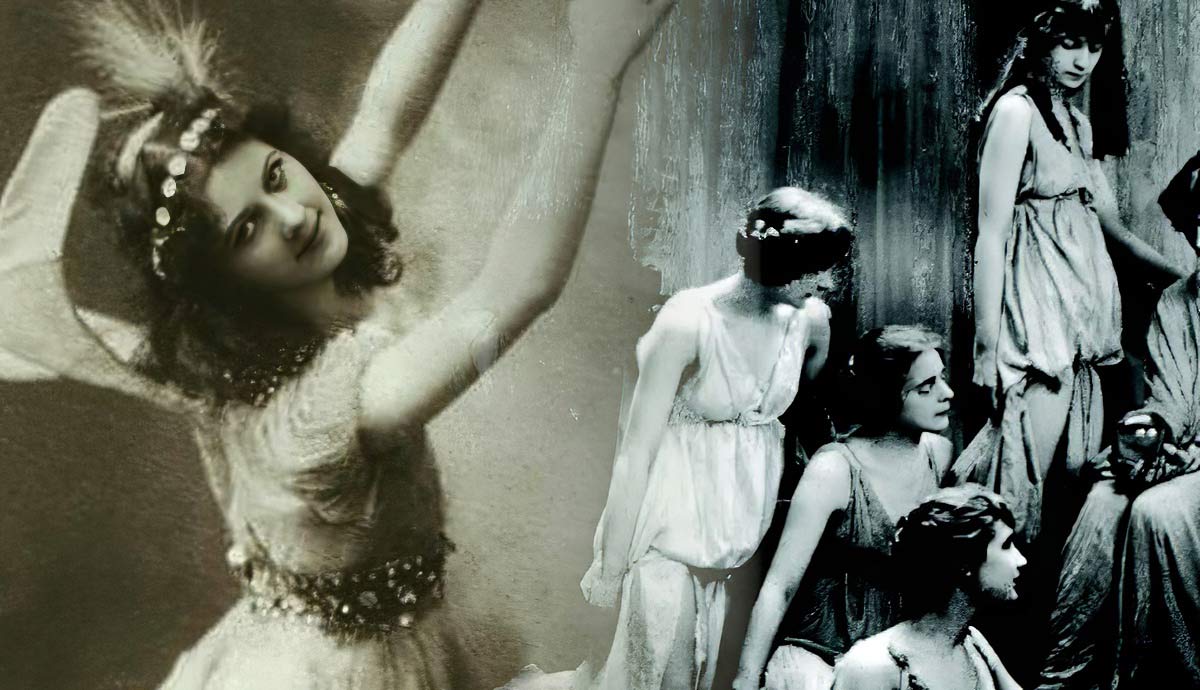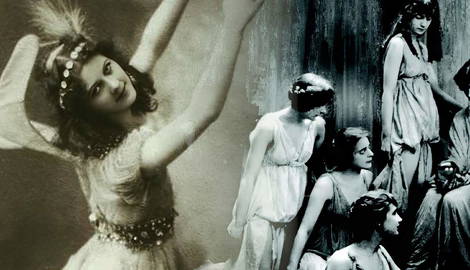
Isadora Duncan was born in 1877, during a time when dancing was mostly constricted to the rigid and highly stylized movements of classical ballet. Likewise, the life path of most women was limited to marriage and taking care of household duties. But Isadora Duncan refused to settle for either. Being a firm believer in freedom of the body, she developed her own way of dancing. She also refused to submit herself to the strict rules set by traditional society.
1. Isadora Duncan’s Parents Divorced When She Was Young

Born in 1877 in the San Francisco Bay Area, Isadora Duncan was the daughter of a banker and a music teacher. While these family circumstances may sound fairly conventional, this was certainly not the case. Her father was a great art lover who engaged in various extramarital affairs. He was also discovered to have used some of the money entrusted to him in private speculations. The financial scandal and the continued infidelity of Isadora’s father quickly proved to be too much for her mother, causing her to divorce him and take her four children to Oakland. What followed was a childhood in humble circumstances, during which Isadora´s mother struggled to make ends meet working as a seamstress and a music teacher. Isadora witnessed the collapse of the institution of marriage at a young age which led her to swear that she would never get married herself.
2. Isadora Duncan Started Teaching Dance Classes at Fourteen

Despite the financial hardships, the young Isadora started dancing very early on, refusing to confine herself to the rules of the ballet schools that taught girls to stand on their toes and tuck in their pelvises. Instead, she and her siblings started putting on their own theater performances and giving dance classes to the neighborhood children. Isadora’s mother actively encouraged her children’s artistic expression and individuality, giving the young Isadora the confidence to seek and teach a form of movement that felt true and natural to her. On top of that, the constant financial struggle taught the young girl resourcefulness when it came to finding creative ways of making money. All this would come in very handy during the many years of ups and downs that would come to define the dancer’s life.
3. Isadora Duncan Found Her First Success Abroad

Isadora Duncan was intent on making it as a dancer, but it took some time for the art world and the public to recognize the unique quality she brought to the world of movement. After unsuccessfully trying to make it in Chicago and New York, the young dancer crossed the Atlantic in 1891 to try her luck in London. Allegedly, the British actress Mrs. Patrick Campbell happened to see Isadora dancing in a garden and became completely enraptured with her. She decided to take her under her wing and introduce her to all of her friends.
What followed were various performances among the crème de la crème of London’s society, catapulting the younger dancer into fame. After many performances in London, extensive touring throughout Europe, and a decade spent in Berlin, Isadora Duncan returned to the USA in 1914. Although she continued to divide opinions wherever she went, her native homeland only accepted her as a serious artist after her success abroad.
4. Her Way of Dancing Was Considered Scandalous

But what exactly was it about Isadora Duncan that made her dance moves so controversial? Being a firm believer in the idea that movement should be an expression of the soul and that dancers were mediums of divine expression, Duncan did not believe in strict and highly stylized movement patterns of ballet or other classical dance styles. In her view, the body was supposed to move freely and naturally. Her commitment to the naturalness and expressiveness of dance prompted her to dance barefoot, which was pretty much unheard of at the time. She also opted to wear flowing robes, which allowed greater freedom of movement and revealed more of her body than the traditional clothes worn by most dancers. All of this caused a lot of outrage among the more closed-minded members of society, turning her into a highly controversial figure.
5. She Was Inspired by Ancient Greece

Today, Isadora Duncan is known as a pioneer of dance and many consider her the creator of modern dance. It may therefore come as a surprise that she was in fact highly inspired by Ancient Greece. She considered herself a priestess more than an artist. According to her philosophy of art, dancing was simply a way of bringing heaven down to earth.
The influence of Classical Greek art could also be found in the way she dressed and moved. Many of her gestures were reminiscent of Greek statues and the paintings found on murals and vases in Ancient Greece. Duncan did not like being filmed, which is why there is only one short video snippet of her dancing.
6. Isadora Duncan Had Three Children by Three Different Men

Isadora Duncan was a free spirit when it came to matters of the heart as well. Instead of getting married, she experienced great love affairs with several men, which also resulted in the birth of her two first children. Her first child, a girl named Deidre Beatrice, was fathered by British theater practitioner Gordon Craig, who Duncan met in Berlin in 1904. A love affair with Paris Singer, the son of a sewing machine magnet, resulted in her second child, Patrick August, in 1910.
While times were certainly changing and the First Wave of Feminism was starting to open up new paths for women, having children out of wedlock, let alone by several men, was still considered highly controversial. Isadora Duncan cared very little about the moral societal values that were designed to keep women in their place, making her personal life choices as revolutionary as her artistic path.
7. All Three of Duncan’s Children Died

Unfortunately, Isadora Duncan´s unconventional motherhood wasn’t meant to last. In 1913, a car carrying both of her children toppled off the road and fell into the River Seine in Paris. The tragic death of her children threw Duncan into a deep well of despair. As she was recovering from the loss, she reportedly begged the Italian sculptor Romano Romanelli to sleep with her, because she was desperate for another child. She became pregnant and gave birth to her third child shortly after, but her newfound motherhood wasn’t meant to last. Her third child died shortly after birth.
8. She Adopted Six of Her Students

While Isadora Duncan did not have any more children after the tragic loss of her first two, and the early loss of her third child, the dancer continued to share her magic with the younger generations across the world. In her view, teaching the young was her highest mission, which is why she opened dance schools in Berlin, Paris, Moscow, and the USA. She even went as far as adopting six of her students in Berlin. While there is no record of the official adaptation process, these six talented girls all took on Isadora’s last name and later became known as the Isadorables. Having come from a poor family herself, it was Isadora’s priority to give opportunities to children from disadvantaged backgrounds. Opening dance schools and mentoring the young was her way of contributing to the liberation of women’s bodies across the world.
9. She Married a Man Much Younger Than Her

Isadora swore that she would never get married, but life was full of surprises. In 1921, she fell in love with the Russian poet Sergei Yesenin and married him one year later. While this may look like an unusually traditional choice for such a free-spirited woman, this was certainly not the case. For one thing, Sergei was 18 years younger than her. To make matters worse in the eyes of traditional American society, Yesenin was Russian.
10. She Was Accused of Being a Bolshevik

When Isadora Duncan and her Russian husband arrived in the USA in 1922, they were detained and accused of being Bolsheviks. Towards the end of the Russian Revolution, the USA was overcome by public hysteria concerning the rise of communism. Isadora Duncan never cared much for public opinion and did nothing to hide her love of Russia.

Having just spent several months in Moscow, she was full of praise for the Russians, claiming that they knew how to appreciate art much better than the people of her homeland. But her alignment with Russia wasn’t the only thing that caused a stir during Duncan’s tour through the USA. Her views on the freedom of the naked human body also clashed with the puritanical values that were still deeply instilled in American society. Following the negative reception during her last visit to her native land, she vowed never to return.
11. Her Husband Died by Suicide

Sergei Yesenin and Isadora Duncan left the United States and tried to build a life in Europe instead. But their love was not meant to last. As the two tried to build a life in Europe, their relationship turned increasingly sour, causing Yesenin to return to Russia. Two years later he was found dead in his hotel room.
12. Isadora Duncan Died in a Tragic Accident

While Isadora Duncan’s life was certainly full of ups and downs, she found herself in a spiral of alcoholism, rising debts, scandalous love affairs, and deepening depression over the death of her children. It hardly feels surprising that her death was as dramatic as her life. While driving away in the car with one of her many lovers, her long scarf got caught in the wheels of the car she was in, strangling her neck and catapulting her onto the street. She died shortly after on the 14th of September in 1927. Her autobiography My Life was published shortly after.










